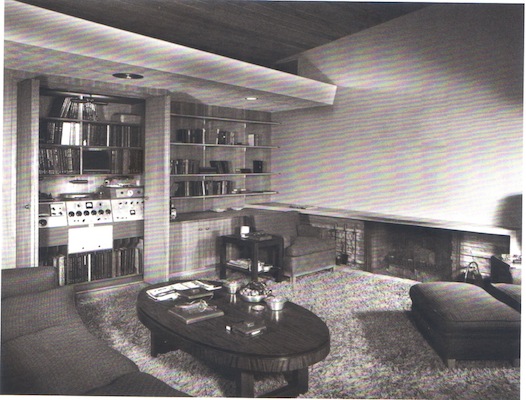
Month: June 2017
John McLaughlin and the “Tonight Show” Big Band: “Cherokee” (1986)
There’s not too much to say about this… the music so confidently speaks for itself.
I first became aware of John McLaughlin upon seeing and hearing his third solo album My Goal’s Beyond. Woober Joobers. I had never heard an Ovation “Roundback” guitar before; and the fact that the original LP album cover showed McLaughlin’s meditation room (and a portrait of his guru, Sri Chinmoy), intrigued me.
Years later, attending Vanderbilt Law School, at an overstock sale at the University bookstore, I bought a book of Meditations by Sri Chinmoy; and: it cut me to the quick.
Quoting from memory: Chinmoy stated that Jesus knew in advance and even predicted that Peter would deny him three times.
But: Chinmoy goes on to say, Jesus chose no one else as the Rock upon whom He would found his church. Continue Reading →
Frank Sinatra’s Hi-Fi, circa 1947
 Photographed in 1949 by Julius Shulman.
Photographed in 1949 by Julius Shulman.
Julius Shulman: Modernism Rediscovered (3 vols.)
Directed and Produced by Benedikt Taschen
Taschen, Cologne, 2016
Vol. 1: 336 pp.; 15.5 x 10.5 x 1.5 inches; 19 pounds total weight for set.
Frank Sinatra signed with Colombia Records in 1943. However, wartime rationing meant that only the so-called “V-Discs” (“Victory Discs”) that were recorded as morale boosters for service personnel overseas could be manufactured. Regular commercial recording resumed only after the end of the war. The Voice of Frank Sinatra, Sinatra’s first “album” of four 78rpm records, was released in March 1946, having been recorded in two sessions on July 30 (Hollywood) and December 7 (New York) 1945. The Voice of Frank Sinatra went to the top of the Billboard chart, and stayed at No. 1 for seven weeks.
Ironically enough, though, it was Sinatra’s contract with movie studio MGM that provided him his first million dollars, enabling him in 1947 to hire architect E. Stewart Williams. At first, Sinatra had wanted a Georgian mansion, complete with brick façade and white columns. But Williams was able to convince Sinatra that the Palm Springs location called for a different style. As you can see above, when originally built, the Sinatra House housed a state-of-the-art 78rpm hi-fi system. Continue Reading →
Joel Fredericksen and Ensemble Phoenix Munich: “Requiem for a Pink Moon”
 Photo Thomas Zwillinger, courtesy of Harmonia Mundi.
Photo Thomas Zwillinger, courtesy of Harmonia Mundi.
Joel Fredericksen and Ensemble Phoenix Munich: Requiem for a Pink Moon
CD Harmonia Mundi HMC 902111 (recorded 2012)
(No high-resolution download available, apparently.)
Joel Fredericksen, bass voice and lute; Timothy Leigh Evans, tenor voice and drum; Domen Marincic, viola da gamba; Axel Wolf, theorbo and archlute; producer and engineer not credited.
Back in December, in my coverage of the Wilson Audio/MSB event at Fidelis AV in New Hampshire, I mentioned how the late-stayers were moved by the cuts I played from Joel Fredericksen and Ensemble Phoenix Munich’s Elizabethan Nick Drake tribute Requiem for a Pink Moon. You could have heard a pin drop. If that album is unknown to you, here’s a brief précis:
The idea of classical bass singer Joel Frederiksen and Ensemble Phoenix Munich’s putting together an early-instruments Elizabethan tribute album to Nick Drake might strike you as daft, as it did me. But, it works. It’s the real deal. There was a melancholic plaintiveness to Drake’s music that is not at all far from the Elizabethan temperament. Frederiksen of course sings both beautifully and un-selfconsciously. But what makes this recording one of the most affecting I have heard in years is that the interleaving of Elizabethan laments and parts of a Gregorian Chant Requiem Mass with Drake’s songs makes such a powerful connection to the universal human experiences of loss and grief, and not just to one particular artist or album. Buy one for yourself, and buy several to give as gifts.


